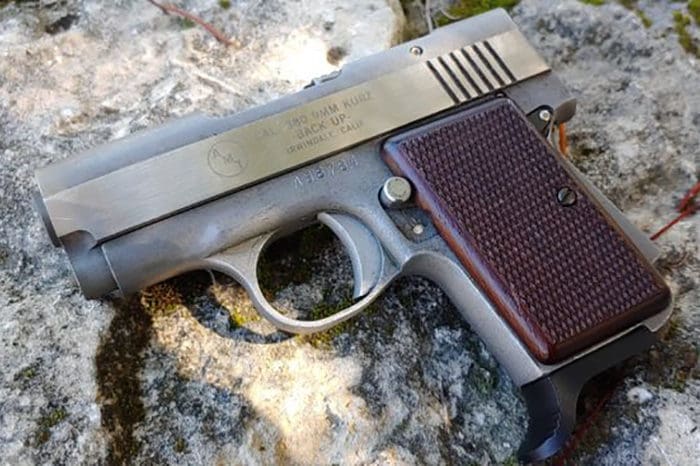Way back when the ultra-small handgun market seemed to be dominated by the J-frame revolver. The small .380 semi-automatic seemed to barely be a thing. Of course, classics like the Walther PPK and PPK/S existed, but compared to modern .380 pocket pistols, these guns were rather large.
The AMT Backup 380 likely seemed either revolutionary or crazy back in 1978 when Ordnance Manufacturing Company made the first models. Arcadia Machine and Tool eventually purchased the design and began pumping out AMT Backups.
This particular model is the earlier single action only model with a manual safety. It came to me for next to nothing, and the fact that it was a mini .380 from the late ’70s piqued my curiosity.
These days you can get a good pocket-sized .380 from nearly any major gun company. GLOCK, Smith & Wesson, Ruger, Kahr and more produce tiny .380s for concealed carry.
The AMT Backup – Ahead of its Time?
The AMT Backup was ahead of its time in a lot of ways. The problem with being head of your time is often not having the technology to flesh out your idea successfully. It was a good idea, but was poorly executed.
The AMT Backup is an all-metal gun without a lick of polymer anywhere. It has 5- and 6-round magazines available. I only have a 6-round magazine with a pinky extension. “Pinky extension” being a joke since it’s still not long enough for my hand. Magazines seem to be available to this day, but they’re a little pricey.
The AMT Backup is a blowback-operated weapon that seems par for the course for .380s from this period. Blowback operation can be a safe and reliable means for a handgun to operate, but it has some flaws.
The first is increased felt recoil. This Backup doesn’t seem to have much muzzle rise, but it has a ton of slap to it. After firing half a box of ammo, my hand felt quite sore. It bruised the area of my palm right below the thumb. It most certainly has some snap to it.
The other downside is the ultra-stiff recoil spring. If you have compromised hand strength, this gun isn’t for you. The near-microscopic rear serrations don’t help much either.
The ergonomics are interesting. The gun uses a heel magazine release at the bottom of the grip to lock in and drop magazines. I imagine the idea of reloading under fire wasn’t really on the designer’s mind when creating a pistol called the Backup.
Where a magazine release would generally be on the grip, there’s a manual safety that slides up for safe and down for fire. It’s effortless to reach and use.
In addition to the manual safety, the AMT Backup also has a grip safety. It seems redundant, but the 1911 was the gun back then, so I’m assuming a grip safety was a selling point. The grip safety also gives you a visual clue if the weapon is cocked.
If the safety is nearly flushed with the grip (above), the gun is uncocked. Once you cock the gun, the grip safety flares outward (below).
Small and Smaller
The all-metal AMT Backup weighs a stout 18 ounces. At 1.06 inches, the firearm is also thick for its size (and not the good thicc). For reference, the SIG P365 holds twice as much ammo in a more capable caliber, and it’s 1.0 inch thick.
The Backup has a short 2.5-inch barrel, an overall length of 5 inches, and a height of 4.1 inches. When compared to the Ruger LCP, they are quite close in size. The LCP is half the weight and about a quarter-inch thinner. Without a doubt, this was an ultra-small .380 ACP for the period and impressive that they found a way to make it work. Mostly.
Mostly Works?
Mostly works is about the best way I can describe this gun. It will not feed hollow point ammunition very well and chokes on stock standard 95 Grain FMJs. Oddly enough, if I fire it with a single hand, the gun works flawlessly. If I take a two-handed shooting grip, the gun chokes and fails to feed.
I tried adjusting my support hand to ensure I wasn’t touching the slide in any way, and it still caused the gun to choke. The one-handed firing is 100% reliable.
The gun has teeny tiny sights that sit flush with the slide. The slide has a trench running down the center of it, and inside the trench are the rear and front sights.
This trench and sight design is well done, and I like the idea when it comes to reducing snag. The sights aren’t great, but if you take your time, the gun can be quite accurate. I managed a respectable headshot group at 15 yards.
Watch the brass ejection, though. It shoots mostly up and to the right, but occasionally they launch straight backward. One got caught in my flannel shirt and gave me a brass burn on the neck. Fun times to be sure.
While the recoil is quite snappy and palm slapping, the little Backup stays on target. The trigger is light with this single-action design, but very spongy.
The reset is also impossible to feel or hear. Several times I thought I had let it out far enough and found I most certainly had not. I just got in the habit of moving my trigger finger all the way out to the trigger guard.
The AMT Backup isn’t a gun I’d carry concealed by any means or would even shoot in a high volume. I’m betting parts are tough to find these days if it needs repairs.
I keep this hefty paperweight around out of an appreciation for the forward thinking that went into it. Even if that forward thinking resulted in a less than stellar gun.
